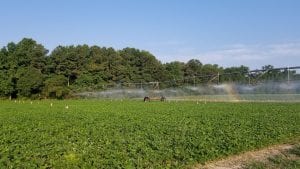Cory Whaley, Phillip Sylvester, James Adkins, Jarrod Miller
Over the last ten years, several Universities have reported that planting soybeans at lower populations doesn’t necessarily reduce yield, but can increase margins. Studies at Ohio State between 2014-2016 indicated better returns with reduced seeding rates and an agronomic optimum planting rate of 150,000 seeds/acre. Both Iowa State and Nebraska have observed that a final stand of 100,000 plants (based on planting 120,000 seeds per acre) does not always reduce yield, but does improve margins due to lower seed costs. Regionally, Virginia Tech recommends higher planting rates for poor ground (120-140,000 seeds/acre), while fields with yield of 55-70 bu/acre could go as low as 90,000 seeds/acre.
In order to test lower seeding rates locally, a study was conducted at the University of Delaware Warrington Research farm in 2017 and 2018. Soybeans were planted at four rates (80, 100, 140, 170k) with and without irrigation in a field with a corn-soy rotation. Asgrow 4135 soybeans were planted on May 18, 2017 and Dynagrow S40LL35 were planted on May 10, 2018. In both years, seeds were planted in 15” rows with a monosem vacuum planter equipped with variable rate seeding technology. Stand counts were taken to determine final population each year (Table 1). Actual stands were 81-90% of the planting rate, with lower emergence and survival as seeding rate increased.
No significant differences were observed (p=0.05) in soybean yield in 2017, 2018, or when both years were combined (Table 2). When potential income across both years was calculated, the lowest seeding rate of 80,000 seeds per acre had the greatest income.
Table 1. Target planting rates and actual plant stands in 2017 & 2018 in a seeding rate study conducted at the University of Delaware Warrington Farm in Harbeson, DE.
| Seeding Rate Treatment | Actual plant stands | ||
| 20171 | 2018 | All | |
| 80,000 seeds/acre | 73 | 70 | 72 |
| 110,000 seeds/acre | 96 | 95 | 95 |
| 140,000 seeds/acre | 123 | 115 | 120 |
| 170,000 seeds/acre | 146 | 129 | 138 |
1Thousand plants per acre
Table 2. Effects of four planting rates on soybean yield and income.
| Seeding Rate | 2017 | 2018 | All | Income1 |
| ———–Yield (bu/acre)———– | ||||
| 80 | 63 | 52 | 59 | $441 |
| 110 | 60 | 54 | 59 | $429 |
| 140 | 63 | 52 | 58 | $409 |
| 170 | 59 | 56 | 59 | $405 |
| F value | 0.58 | 0.61 | 0.99 | |
1 Income was calculated using average yields from each seeding rate (irrigated and non-irrigated combined) across both years multiplied by $8.00 per bushel, minus cost of seed at $55 per 140,000 seed unit.
The use of irrigation improved yields by 19 bu/acre in 2018, while there was a 7 acre/bu averaged across both years (Table 3). No advantage was measured in 2017, which may be due to adequate rainfall balancing the need for irrigation. Compared to the previous summer, rainfall was lower during a critical reproductive stage, potentially lower yields in non-irrigated plots. Normalized difference vegetation index (NDVI) was used to monitor plant growth over the summer 2018 (Figure 1). Plot borders are present on June 12 and July 3, by July 13 most variability in NDVI appears to be soil related rather than planting rate. On August 27th most plots under irrigation have reached full canopy, which is reflected in the NDVI (Figure 1, blue arrow). Alternatively, the non-irrigated plots typically have lower NDVI values, with soil variability (probably due to water holding) present.
Our results are consistent with those from other parts of the US, where lower seeding rates don’t necessarily result in a lower yield. This study was only performed on one soil type though, and may not have similar results across the state. Achieving good stands at lower planting rates will require proper planting depths and good seed to soil contact. Irrigation during dry periods will, at a minimum, protect yields.
Table 3. Effects of irrigation on soybean yield, regardless of population.
| Irrigated | 2017 | 20181 | All | |||||
| Yes | 63 | 63 a | 60 a | |||||
| No | 59 | 44 b | 53 b | |||||
| F value | 0.14 | <0.0001 | <0.0001 | |||||
1Treatment means followed by the same letter are not significantly different.
Figure 1: NDVI of the soybean study on four different dates in 2018. Blue and yellow arrows represent randomly placed irrigated and non-irrigated plots, respectively.

